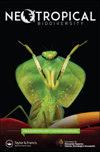Hospederos y patrones de prevalencia de parásitos aviares Philornis (Diptera: muscidae) en la costa de Ecuador
IF 0.8
Q4 ECOLOGY
引用次数: 0
Abstract
Most of the species of the genus Philornis are obligate parasites of birds’ nests, especially affecting small populations. However, research on factors influencing its distribution is scarce. This study focuses on analyzing some elements that facilitate the parasitism of this genus on several species of birds in continental Ecuador. From a sample obtained over two years (2019-2020) in five different locations on the country’s coast, 693 nests of land birds and raptors were analyzed. Of these, 13% were parasitized. Two Philornis species already reported for Ecuador (Philornis downsi, P. niger) and two morphotypes not previously registered in the country were recorded, preliminarily classified as P. sp. nr. bellus and P. sp. nr. falsificus. The species with the highest proportion was P. downsi, both in terms of nest prevalence and intensity. Each species of the parasite showed an affinity for one or more families of birds and it was evidenced that the shape of the nest facilitates the prevalence of Philornis. The prevalence of Philornis decreases in higher places in the dry coastal forests. The probability of infection was also influenced by habitat alteration: nests from disturbed sites have a higher prevalence of parasites than nests with natural forest (P = 0.002). The present study strengthens the existing knowledge about different environmental factors that influence Philornis parasitism birds of continental Ecuador.厄瓜多尔海岸鸟类寄生虫Philornis(双翅目:蝇科)的寄主和流行模式
Philornis属的大多数物种是鸟类巢穴的专性寄生虫,特别是影响小种群。然而,对其分布影响因素的研究却很少。本研究的重点是分析促进该属寄生在厄瓜多尔大陆几种鸟类上的一些因素。从两年(2019-2020年)在该国沿海五个不同地点获得的样本中,分析了693个陆地鸟类和猛禽的巢穴。其中,13%被寄生。记录了厄瓜多尔已报告的2种菲洛尼斯(downsi菲洛尼斯,尼日尔菲洛尼斯)和2种以前未在该国登记的形态,初步分类为贝勒菲洛尼斯和假菲洛斯菲洛尼斯。在筑巢率和筑巢密度方面,比例最高的是唐氏斑蝶。每一种寄生虫都表现出对一个或多个鸟类家族的亲和力,并且证明了巢的形状有助于Philornis的流行。在干燥的沿海森林中,高海拔地区的Philornis患病率降低。感染的概率也受到栖息地改变的影响:受干扰地点的巢穴比天然森林的巢穴有更高的寄生虫患病率(P = 0.002)。本研究加强了对影响厄瓜多尔大陆菲洛尼寄生鸟类的不同环境因素的现有认识。
本文章由计算机程序翻译,如有差异,请以英文原文为准。
求助全文
约1分钟内获得全文
求助全文
来源期刊

Neotropical Biodiversity
Environmental Science-Ecology
CiteScore
1.80
自引率
0.00%
发文量
39
审稿时长
24 weeks
 求助内容:
求助内容: 应助结果提醒方式:
应助结果提醒方式:


